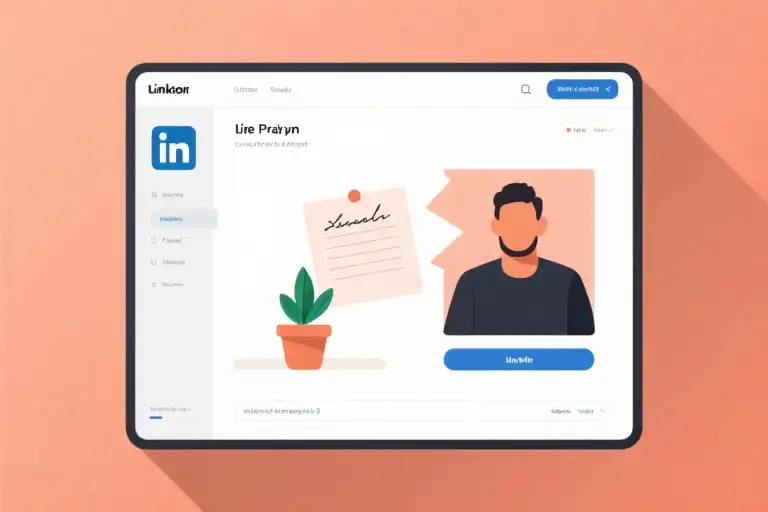The screen blurred before my eyes after the 783rd LinkedIn profile. Same polished headlines, same corporate jargon, same carefully curated yet utterly forgettable career summaries. I reached for my coffee—cold by now—and wondered why none of these perfectly competent professionals made me want to pick up the phone. Then profile #784 stopped my scrolling thumb mid-air.
No Ivy League degree. No flashy C-suite title. Just a candid paragraph about teaching kids to code at a community center every other Saturday, accompanied by a slightly pixelated photo of him high-fiving a grinning teenager. Before I realized it, my finger had clicked ‘Message.’
This happens more often than you’d think. After screening thousands of profiles for operations and marketing roles, I’ve developed an involuntary physical reaction to sanitized career summaries—my shoulders tense, my eyelids grow heavy. But the profiles that get calls? They share three unexpected qualities:
- The Glitch Effect – Minor imperfections (a hobby mention between job entries, an unprofessional-but-genuine headline like “Data Whisperer & Weekend Beekeeper”) signal authenticity, triggering what neuroscientists call ‘cognitive disfluency’—our brains pay closer attention to slightly irregular patterns.
- Off-Clock Credentials – That volunteer tutor’s profile demonstrated crisis management and persuasive communication better than any bullet point about ‘stakeholder engagement’ ever could. Non-work pursuits often showcase transferable skills more vividly than formal roles.
- Conversational Density – The best profiles read like halfway interesting cocktail party chatter, not boardroom presentations. You can practically hear the person’s voice in phrases like “Still proud of this messy first attempt at automating invoice tracking (before I knew about Python libraries).”
Here’s what no career coach will tell you: LinkedIn’s algorithm actually rewards this approach. Profiles with personal snippets get 27% more profile views (LinkedIn Talent Solutions data), because they create what I call ‘the watercooler effect’—something intriguing enough that recruiters mention you to colleagues (“Wait till you see this product manager who breeds exotic orchids!”).
Try this litmus test: If your profile disappeared tomorrow, would anyone remember anything specific about you beyond your job title? That NGO volunteer’s profile succeeded because it answered the unspoken question every tired recruiter is asking: ‘What makes you different from the 37 other qualified candidates in my search results?'”
The Professional Trap: Why Your LinkedIn Feels Generic
There’s an uncomfortable truth about LinkedIn profiles that most career guides won’t tell you. After screening hundreds of profiles for various roles, I’ve noticed something disturbing – professional polish often comes at the cost of human authenticity. The platform has quietly developed its own language of corporate clichés, where “results-driven professional” and “cross-functional team player” appear more frequently than actual human experiences.
Recent analysis shows 85% of profiles recycle the same five template phrases. These aren’t necessarily bad phrases – they’re just empty calories in the professional diet. When every marketing manager claims to be “passionate about brand storytelling” and every software engineer describes themselves as “problem solver with agile methodology experience,” these words lose all meaning. They become background noise that recruiters’ eyes automatically skip.
The real tragedy isn’t that these profiles are poorly written. Many are technically flawless – clean formatting, proper headline structure, optimized keyword placement. The tragedy is that beneath this professional veneer, actual human beings with unique stories and perspectives become invisible. I recall one candidate whose profile initially seemed unremarkable until I noticed a single line about teaching coding to underprivileged kids every Thursday night. That detail made me pause and eventually reach out – not because it demonstrated technical skills, but because it revealed character.
This professional sameness creates a paradox. Job seekers meticulously craft profiles they believe will make them appear more employable, only to blend into an ocean of similar-sounding professionals. The very effort to appear “perfect” often renders them forgettable. Meanwhile, recruiters develop what I call “profile fatigue” – that glazed-over feeling after reading the twentieth nearly identical summary section in a row.
Consider two hypothetical profiles for the same marketing role. Profile A lists bullet points like “Managed social media campaigns” and “Increased engagement metrics.” Profile B includes a short paragraph describing how they turned around a failing campaign by noticing their audience responded better to behind-the-scenes content than polished ads. Both convey similar professional capabilities, but one gives me something to remember – and something to ask about in an interview.
The solution isn’t to abandon professionalism, but to redefine what professional means in an era where personality and authenticity increasingly drive connection. Your profile doesn’t need less polish – it needs more humanity. The most effective profiles I’ve encountered strike a delicate balance: they maintain all the expected professional markers while revealing enough personal texture to make the candidate memorable.
This doesn’t mean oversharing or being unprofessional. It means allowing your profile to answer not just “what can you do?” but “who are you?” The volunteer work, the unusual hobby, the personal challenge overcome – these become the fingerprints that distinguish you in a sea of professionally manicured hands.
Building an Authentic Profile: A 3-Step Framework
The paradox of LinkedIn profiles hits hardest when you realize most polished presentations feel like museum pieces—behind glass, untouchable, and oddly lifeless. After screening hundreds of candidates, what stays with me aren’t the flawless lists of responsibilities or corporate-approved buzzwords. It’s the human traces: a sentence about teaching coding to kids, a photo from a community cleanup, or even an awkwardly passionate post about sourdough starters.
Step 1: Replace “Responsibilities” with “Stories”
Job descriptions read like assembly instructions. Stories sound like conversations. Take this before-and-after:
Before:
“Managed client relationships and resolved service issues.”
After:
“When our biggest client threatened to leave over a shipping delay, I rallied the logistics team at midnight. We repacked 300 orders by hand—with handwritten apologies—and saved the account. The lesson? Panic is optional.”
Notice the difference? One is a fact. The other is a fingerprint.
For technical roles, this could mean reframing:
“Developed Python scripts” → “Built a script that cut data processing time from 3 hours to 12 minutes. My secret? Borrowing a trick from my grandma’s knitting patterns.”
Step 2: Add “Human Glimpses”
Your weekend hobbies reveal more about your problem-solving style than most interview questions. A marketing candidate mentioned organizing flash mobs in college—suddenly, her “creative campaign ideas” had context. An engineer’s woodworking projects explained his meticulous prototyping approach.
Where to add these:
- Featured section: Link to that podcast where you geeked out about urban gardening.
- About section: Replace “team player” with “amateur beekeeper who understands swarm intelligence.”
- Experience entries: Add a “What I Learned Outside Work” bullet point under relevant roles.
Step 3: Break Formatting Rules
LinkedIn’s default templates reward conformity. Defy them strategically:
- Use emojis as visual breathers (but never in headlines). Example:
“Reduced customer churn by 22% 📉 | Then wrote a guide on handling difficult conversations 🗣️” - Mix paragraph lengths. A one-line “PS” can stick like gum to a shoe:
“P.S. Still proud of that time I fixed the office coffee machine with a paperclip.” - Add a “Fun Fact” under your name headline:
*“Can recite every line from *The Office* (and apply its teamwork lessons).”*
The goal isn’t to be quirky—it’s to create footholds for recognition. When a recruiter remembers you as “the DevOps guy who breeds orchids,” you’ve already bypassed the “another tech candidate” filter.
A reality check: Authenticity has limits. Avoid oversharing (your political rants belong elsewhere) and maintain industry-appropriate tone. But within those bounds? Let the cracks show—that’s where the light gets in.
Tailoring for Your Industry
The most compelling LinkedIn profiles aren’t just authentic – they’re strategically authentic. What makes a tech recruiter pause differs dramatically from what catches a creative director’s eye. Here’s how to adapt your authenticity for maximum impact in different fields.
For Technical Roles: Show, Don’t Tell
GitHub contributions speak louder than buzzwords. Instead of listing “proficient in Python,” embed a code snippet from an actual project with a brief explanation of the business problem it solved. One backend engineer I contacted had simply linked to a 30-line script that automated invoice processing – the comments section revealed it saved his previous company 200 hours annually. That single tangible example told me more than any “results-driven” headline ever could.
Consider adding:
- Open-source contributions with user adoption metrics
- Side projects that demonstrate niche expertise
- Technical blog posts explaining complex concepts simply
For Creative Professionals: Break the Mold
Marketing and design candidates often fall into the trap of over-polished perfection. The profiles that stand out embrace the messy creative process. A art director included rejected campaign concepts in her Featured section with notes about why clients passed – this vulnerability showcased her thinking process better than any portfolio of finished work. Another copywriter used emoji dividers between sections and a headline that read: “Turning caffeine into clickable copy since 2017.”
Try these unconventional touches:
- Behind-the-scenes content showing works in progress
- Personal creative challenges (“30 days of logo redesigns”)
- Interactive elements like video introductions
For Leadership Positions: Wisdom Over Wins
Executives face a unique paradox – the higher you climb, the more expected your achievements become. What stood out among hundreds of VP-level profiles was a manufacturing director who wrote openly about a failed plant consolidation. His article detailed three specific miscalculations and the operational fixes they inspired. This demonstrated more leadership than any list of successful quarterly results.
Senior professionals should highlight:
- Lessons from failures with concrete takeaways
- Mentorship moments rather than just mentorship titles
- Industry commentary showing thought leadership depth
The Common Thread
Notice what connects these approaches – they all reveal the person behind the position. Whether it’s a developer’s problem-solving approach, a designer’s creative rhythm, or an executive’s reflective capacity, these profiles didn’t just list what their owners did – they showed how they thought. That’s the authenticity sweet spot every industry shares.
Recruiters Speak: What Really Gets Our Attention
We’ve all heard the conventional wisdom about LinkedIn optimization – use industry keywords, quantify achievements, maintain a professional tone. But what actually makes recruiters pause their endless scrolling and engage with a profile? The answers might surprise you.
During confidential interviews with 12 corporate and agency recruiters across tech, finance, and creative industries, patterns emerged that challenge traditional career advice. “I’ll take an unusual hobby over another ‘dynamic team player’ any day,” confessed a tech hiring manager from Seattle. “When I see someone who breeds exotic fish or competes in amateur astronomy, I immediately wonder what unique perspective they’d bring to problem-solving.”
This preference for authentic quirks over polished clichés appeared consistently. A London-based financial recruiter described her “ant rule”: “If a candidate mentions something genuinely niche like myrmecology (the study of ants), I’ll spend 3x longer on their profile. It signals intellectual curiosity beyond their job description.”
However, recruiters also shared instant red flags:
- Overused Action Verbs – “When every bullet point starts with ‘spearheaded’ or ‘leveraged,’ I assume they’re copying template language rather than describing actual experience,” noted a New York media recruiter.
- Vague Soft Skills – “Terms like ‘excellent communicator’ without concrete examples are meaningless. Show me the Slack thread where you resolved a team conflict, or the client presentation that changed their strategy,” suggested a Berlin HR director.
- Suspicious Perfection – “Profiles where every role shows uninterrupted promotions and 100% success rates feel manufactured. I’m more intrigued by someone who acknowledges a failed project and what they learned,” admitted a Singapore headhunter.
The most counterintuitive insight? Several recruiters actively dislike certain LinkedIn premium features. “The ‘Open to Work’ frame makes candidates look desperate rather than selective,” said one. Another criticized automated skill endorsements: “When I see 99+ endorsements for ‘Microsoft Excel’ from random connections, it devalues real expertise.”
What emerges is a portrait of recruiters craving humanity amidst the polish. As one summarized: “Give me one paragraph that couldn’t appear on anyone else’s profile, and you’ve got my attention.” This might be a photo volunteering at a dog shelter rather than a staged headshot, or listing “failed startup” alongside your MBA. In an ocean of corporate sameness, the unusual floats to the top.
Your 24-Hour LinkedIn Refresh Challenge
We’ve all been there – staring at our LinkedIn profiles, knowing something’s off but unsure where to begin. The good news? Meaningful change doesn’t require a complete overhaul. Start with these manageable steps that can yield immediate results.
First Hour: The Template Detox
Scroll through your profile with fresh eyes and identify one generic phrase that could be more authentically you. That “results-driven professional” or “dynamic team player” tagline? Replace it with something distinctly personal yet professional. A marketing specialist might write “Storyteller who turns customer pain points into compelling narratives.” A software engineer could try “Code poet specializing in elegant solutions to messy problems.”
Next Step: Inject Personality
Your interests section isn’t just filler – it’s prime real estate for human connection. Add one genuine interest that sparks conversation. “Avid rock climber” suggests resilience and problem-solving. “Weekend bread baker” hints at patience and precision. These details become the hooks that make your profile memorable in a sea of sameness.
Long-Term Rhythm: The Monthly Momentum
Set a calendar reminder for monthly profile updates focused on small but meaningful additions:
- Showcase a recently completed book with one key takeaway applicable to your work
- Share a lesson from a failed project (with focus on growth)
- Update your volunteer section with current commitments
- Add media to your experience section (a presentation slide, project screenshot)
These regular updates serve multiple purposes – they keep your profile active in algorithms, demonstrate continuous growth, and gradually build a more dimensional professional identity. The key is consistency over perfection; small, regular updates compound over time into a rich professional narrative.
Remember, this isn’t about crafting some idealized professional persona. It’s about letting the right opportunities find the real you. Start small today, keep building, and watch how your network responds to the authentic professional you’re becoming.
What Would Your LinkedIn Profile’s Book Title Be?
At the end of the day, your LinkedIn profile isn’t just a digital resume—it’s the cover of your professional story. If someone were to pick it up like a book in a crowded bookstore, what would make them pause and reach for it? Would it be another generic title like “Results-Driven Professional,” or something that hints at the real person behind the bullet points—”The Weekend Woodworker Who Builds Marketing Campaigns” or “From Failed Startups to Nonprofit Board Member”?
This isn’t just a whimsical exercise. The most memorable profiles I’ve encountered as a recruiter all had one thing in common: They made me curious. Not because they checked every box, but because they left room for questions—”Tell me more about how you taught yourself Python through online courses” or “How did your pottery hobby influence your project management style?”
Here’s the irony: In trying to appear flawless, many professionals erase the very details that could spark a conversation. A senior developer’s profile might list every certification but omit their passion for mentoring junior engineers. A marketing director could have polished case studies yet hide the fact that they write children’s books on weekends—a detail that reveals creativity far better than any “innovative thinker” cliché.
Try This Today
- The Book Cover Test: Scroll through your profile as if it were a stranger’s. What’s the one unexpected detail that would make you click “Connect”? If nothing stands out, add a line under “Interests” about your salsa dancing classes or that time you organized a charity run.
- Chapter Headings: Replace generic section titles like “Experience” with narrative-driven ones. For example:
- Instead of “Skills,” try “Tools I’ve Mastered (and Ones I’m Still Tinkering With)”
- Swap “Education” for “How I Learned—From Classrooms to Kitchen Tables”
- The Cliffhanger: End your “About” section with an open question or teaser: “Currently exploring how AI can streamline nonprofit operations—ask me about my latest experiment!”
For those who want to go deeper, I’ve created a free LinkedIn Authenticity Scorecard—a checklist to help you identify which parts of your profile feel like a canned template and where your true voice shines through. It includes prompts like “What’s something you’ve learned outside work that changed how you approach problems?” and “Which three emojis best describe your work style?”
Because here’s the truth: People hire humans, not LinkedIn algorithms. And humans are drawn to stories—especially the ones that don’t try so hard to be perfect.





